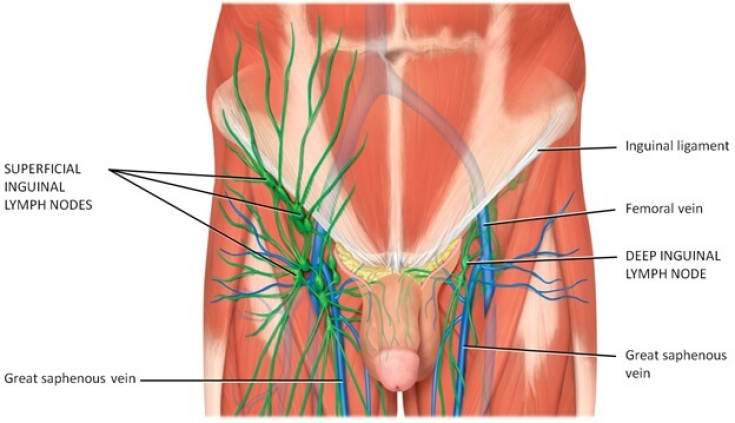The development of many diseases occurs with an increase in lymph nodes.
Almost all acute processes in the body occur with reaction of lymph nodes in the form of their enlargement.
However, there are diseases in which the lymph nodes are affected to a greater extent and in the first place.
Among such diseases are venereal lymphopathy, or inguinal lymphogranulomatosis, or tropical bubo.
The causative agent of the disease is Chlamydia.
Read more on estet-portal.com about the signs and clinical presentation of inguinal lymphogranulomatosis.
- Prevalence, cause and routes of infection of inguinal lymphogranulomatosis
- Clinical manifestations of the primary period of inguinal lymphogranulomatosis
- Manifestations of the secondary period of inguinal lymphogranulomatosis
- Clinical symptoms of the tertiary period of inguinal lymphogranulomatosis
- What diseases are differential diagnostics of lymphogranulomatofor
Prevalence, cause and routes of infection of inguinal lymphogranulomatosis
Inguinal lymphogranulomatosis is most common in subtropical and tropical climates, that is, among the inhabitants of Australia, Africa, Latin America and Asia.
In recent years, inguinal lymphogranulomatosis has become registered in other countries of the world due to the development of tourism.
Lymphogranulomatosis occurs, as a rule, in young people who are sexually active.
It has been noted that the disease is more common in men, namely sailors, military men, travelers and homosexuals.
The causative agent of inguinal lymphogranulomatosis - chlamydia.
However, prior to research, the disease was thought to be of viral origin.
Path of transmission – sexual, or contact - through intimate items.
Chlamydia is transmitted through broken skin or mucous membranes of the genitals.
It is women who are epidemiologically dangerous, as they can be infected, but their symptoms appear much later.
Infection occurs either from a sick person, or from a carrier of inguinal lymphogranulomatofor.
Lymphatic drainage: a waste of time or a useful tool for a beautician
Clinical manifestations of the primary period of inguinal lymphogranulomatosis
Clinical manifestations of inguinal lymphogranulomatosis begin to appear after an average of 2 weeks.
The incubation period ranges from a few days to several months.
The symptomatic picture is divided into 3 periods lymphogranulomatosis: primary, secondary and tertiary.

Primary Period – is characterized by the appearance of primary affect at the site of chlamydia introduction.
Primary affect is represented by erosion or ulcer. After a few days, the ulcer heals without leaving any trace.
Therefore, in almost all patients the primary period goes unnoticed and they do not go to the doctor.
Localization of the primary affect can be different – rectum, anus, urethra, external genitalia, mucous membrane of the lips, larynx or tonsils (after oral intercourseta).
Follow us on Facebook!
Manifestations of the secondary period of inguinal lymphogranulomatosis
Secondary period develops against the background of spread of the pathogen through the lymphatic vessels.
In case of infection with lymphogranulomatosis sexually, femoral and inguinal lymph nodes are affected with the development of regional lymphadenitis and lymphangitis.
If the primary affect is in the region of the mouth and larynx, cervical and submandibular lymph nodes.
Symptoms develop 2-4 weeks after initial symptoms.
In the lymph node with inguinal lymphogranulomatosis, signs of an inflammatory reaction develop:
- soreness of the lymph nodes;
- increase them in size;
- edema;
- skin redness;
- Increase in local temperature.
Over time, the lymph nodes form into large tumors with a bumpy surface, lose their mobility due to soldering with underlying tissues.
After that, in the lymph nodes, the process of purulent fusion of the tissues of the node occurs with the formation of fistulas and ulcers, through which the purulent contents come out.
The purulent process can spread to nearby tissues with the development of purulent arthritis, osteomyelitis or pyoderma.The process of suppuration is accompanied by symptoms of a violation of the general condition:
- chills;
- headache;
- myalgia;
- joint pain;
- increase in body temperature.
symptoms subside, lymph nodes decrease in size, fistulas become scarred.
Butthe infection spreads to other lymph nodes and the process gains new momentum, which is accompanied by the next exacerbation of inguinal lymphogranulomatosis.
The course of the disease with exacerbations and remissions canlast several years.
If left untreated, lymphogranulomatosis develops and passes to the next stageSwollen cervical lymph nodes: correct diagnosis
Clinical symptoms of the tertiary period of inguinal lymphogranulomatosisThe tertiary period is characterized by impaired lymph circulation in the pelvic organs.
Against this background,genitorectal elephantiasis and lymphostasis develop, which is accompanied by dysfunction of the pelvic organs.
The tertiary period of inguinal lymphogranulomatosis is characterized by the appearance of ulcers on the pelvic organs, which contribute to the formation of fistulas.When the ulcer is localized in the urethra, urethral stricture may develop, which greatly complicates the process of urination, urinary incontinence begins. Ulcers in the rectum contribute to the development of paraproctitis, ulcerative colitis or intestinal obstruction
Clinical case of complex diagnosis Skin T-cell lymphoma
What diseases are differential diagnostics of Hodgkin's diseaseTo confirm the diagnosis of inguinal lymphogranulomatosis,
bacteriological culture of secretions from the urethra, rectum, vagina, punctate of the lymph node is performed.
ELISA, RIF and PCR – research. In order to exclude a malignant neoplasm of the node, it is biopsied.
Other studies are also required:
- pelvic organs;
-
Ultrasound of lymphatic vessels; consultations of related specialists. - It is important to make a differential diagnosis with such diseases
- :
secondary syphilis;
-
genital
tuberculosis; inguinal lymphadenitis; - malignant tumor metastases. Inguinal lymphogranulomatosis is treated with antibacterial drugs
- in combination with restorative agents.
- In some cases, surgery is required
The lymphatic system of the body: guarding the whole body







Add a comment